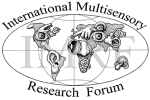June 5-8, 2005, Rovereto, Italy, in a symposium on Monday June 6, 2005 titled
![]() "Can the Blind See?",
organized by Alvaro Pascual-Leone of Beth Israel Deaconess Medical Center, Harvard Medical School, Boston, USA.
"Can the Blind See?",
organized by Alvaro Pascual-Leone of Beth Israel Deaconess Medical Center, Harvard Medical School, Boston, USA.
 Authors
Authors
Amir Amedi
Peter Meijer
in proficient blind users Sensory substitution devices (SSD) can play a role in rehabilitation of the blind with restoration of visual functions by: (1) assisting in daily-life activities such as recognizing visual objects (2) "guiding" visual cortex to interpret information arriving from visual prostheses. We report here behavioral and neuroimaging results in blind expert users of "The vOICe" visual-to-auditory SSD, which transforms live camera views into "soundscapes" by encoding key image aspects. Object recognition versus location processing of visual shapes encoded by "The vOICe" was compared to tactile object identification. A right-hemisphere lateralized network appears to participate in processing soundscapes. Interestingly, differential activation of ventral V1/V2 is associated with shape versus location tasks. These results suggest that similar to visual processing, soundscapes activate the ventral visual stream to process shape information, while posterior parietal cortex contributes to location processing. We will discuss these results within the context of visual rehabilitation and restoration efforts. Other presentations in this symposium:
|
Presentation references
M. A. Goodale and D. A. Milner, ``Separate visual pathways for perception and action,'' Trends in Neuroscience, Vol. 15, pp. 20-25, 1992.Related is also the April 2005 conference presentation at CNS 2005 about results obtained with The vOICe. At IMRF 2006, there was the poster presentation by J.-K. Kim and R. J. Zatorre on ``Visual-to-auditory substitution learning: Behavioral findings and neural correlates,'' for which the abstract is availableP. B. L. Meijer, ``An Experimental System for Auditory Image Representations,'' IEEE Transactions on Biomedical Engineering, Vol. 39, No. 2, pp. 112-121, Feb 1992. Reprinted in the 1993 IMIA Yearbook of Medical Informatics, pp. 291-300.
L. B. Merabet, J. F. Rizzo, A. Amedi, D. C. Somers and A. Pascual-Leone, ``Opinion: What blindness can tell us about seeing again: merging neuroplasticity and neuroprostheses,'' Nature Reviews Neuroscience, Vol. 6, pp. 71-77, 2005.
M. Mishkin, L. G. Ungerleider and K. A. Macko, ``Object vision and spatial vision: Two cortical pathways,'' Trends in Neuroscience, Vol. 6, pp. 414-417, 1983.
Note: The vOICe technology is being explored and developed under the Open Innovation
paradigm together with